|
|
|
|
|
|
|
|
|
|
|
Altars |
|
Altars are spoken of many times throughout Scriptures, beginning in Genesis and ending in Revelation. Not only are there altars to the one true God, there are references to altars being erected for pagan gods and by pagan people. Archaeological excavations have found multitudes of such structures, varying in size and specific purpose. Some, tending toward a belief in a natural evolution of religious functions, have speculated that the usage of altars in Scriptures comes from an earlier paganistic view that altars were tables for the gods.1
This quote is accurate in stating that such imagery is not easily recognized in the Old Testament, or the entirety of Scriptures, in regards to worship of the true God. Why? Because this is not valid imagery, rather it is a corruption later employed by pagans and counterfeit worshippers. God never portrays Himself as needing anything, much less to eat or need someone to feed Him...
|
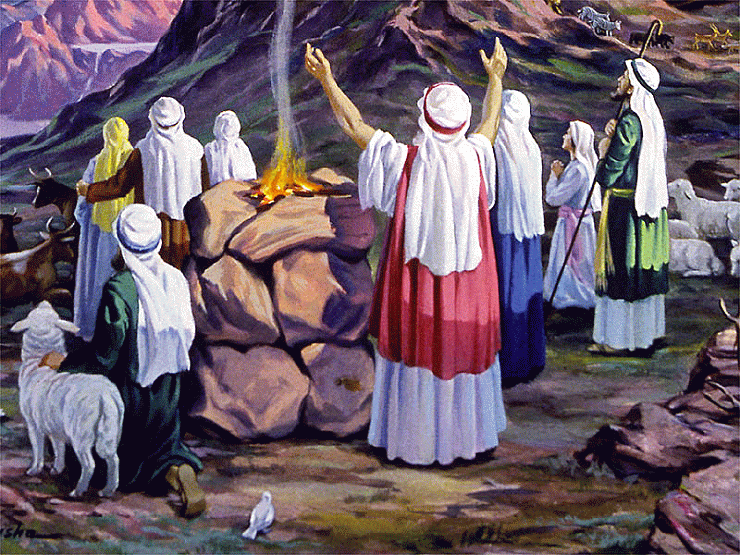
Noah and his family offering a sacrifice on an earthen altar. (Copyright and origin of painting unknown)
|
The earliest specifically mentioned altar is found in the account of Noah, immediately following the flood. While usage of an altar may be implied as far back as Genesis 4:3-4, with the offerings of Cain and Abel, it is nothing more than implication. The first, that God clearly defines, comes also with clear symbolism on which all further references build.
What had been cursed by the sin of man - literally twice cursed in regards to the sinfulness of Cain in perpetrating the first murder - is such a potent symbol of the depravity of man.
The very ground out of which Adam was formed (Genesis 2:7), the ground to which death would have him and his offspring return (brought about by sin, see Romans 5:12), was the recipient of the curse. Now, in the first specific example of an altar, this mound of dirt, or rock, was where the lifeblood of the sacrifice was poured out. As a burnt offering, it was also then burned by fire, in turn producing an upward rising aroma. Together these things portray so greatly the need of man. The blood on the ground graphically symbolizes our need of blood sacrifice to cover the curse brought about by sin. That it fell on the ground affected by the first sin (in rebellion against his Creator) and the worst sin (taking the life of one made in the image of the Creator) shows that forgiveness is available for our inherited sinfulness and the willful sins we have all committed, no matter how serious. The aroma from the burnt offering dramatizes the upward need of our focus. It is to God that we look for this forgiveness, it is to God that we must pray, it is to God that we direct all our cares and needs, and it is to God that we offer all gratitude and praise! |

Meggido Round Altar - Canaanite - Circa 2500-1800 B.C.

Altars at Arad (circa 10th century B.C.).
Foreground
sacrificial altar: This Israelite altar followed the command to not
use shaped stones.
Background:
Two incense alars in front of standing stones representing Yahweh
and Ashtoreth...
Showed
that this was a site of worship in opposition to Law's commands to
only worship God
and
only at the Jerusalem temple. See link to Arad
for more images.
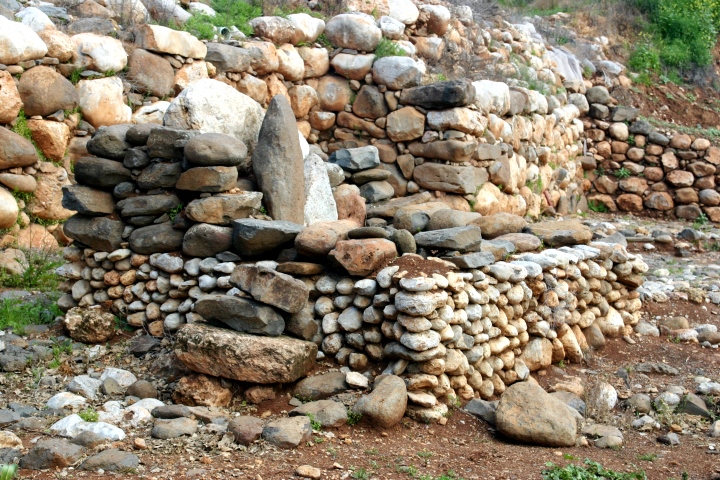
An "high place" altar at Tel Dan, made from natural stone. Also has standing stones similar to Arad (above)
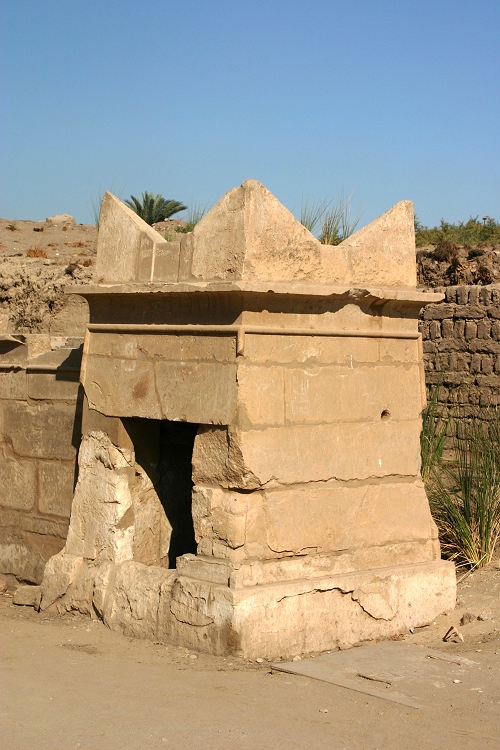
A small horned altar at Karnak Temple in Egypt
|
The Law of Moses - which increased the burden of man (to further show his sinfulness) - also adds to the symbolism of the altar. In ancient times it would have been easy and natural to use the rocks of the ground as an altar, whether many or few (i.e. Judges 13:19-20; 1 Samuel 14:33-35). By the time of the Law, God, knowing the propensity of man to elevate his sense of self importance in matters of salvation, specifically limited what an altar should be made of.
Just as we defile salvation by trying to mix grace with works (Romans 11:6; Galatians 5:4; Ephesians 2:8-9), so too did works in shaping stones believing that it somehow made them (or the sacrifice upon them) more acceptable to God. The altar was God's workmanship - His dirt! The entire focus of sacrifices and altars was to point to the need of a perfect sacrifice, namely Jesus Christ. Consider where Jesus' blood was finally shed - on Golgotha. This prominent mound of rock and dirt was the all natural altar that had the blood of our Savior split on it. The cursed ground was covered by His blood. Students of Scriptures are possibly thinking, "Wait a minute, didn't the tabernacle and subsequent temple have shaped altars?" And they certainly did. These altars, while adhering to still applicable regulations such as not having steps, were based on a different principle. Unlike all other sanctioned altars, they were not to solely portray the earthly condition but rather provide a reflection of heaven.
The earthy sanctuary was, by Heavenly command, fashioned as a representation of the perfect one in heaven. This one, no matter how well crafted, was created by man and could never be perfect. In fact, as was shown throughout Israel's history, it could also be defiled by man. For these reasons the focus was never to be this earthy copy, it was to be the unchangeable heavenly original. All tabernacle and temple sacrifices pointed to the need of a perfect permanent sacrifice, which likewise required a perfect Most Holy Place, altar, and implements. The earthly Most Holy Place, a temporary dwelling place for the Name of God, wouldn't do. Jesus, as High Priest and Sacrifice, entered the permanent Most Holy Place, the actual dwelling place of God.
The need for altars ceased when they had fulfilled their purposes. With Christ's once-for-all perfect sacrifice on this earthly altar (Golgotha), and his subsequent offering of his blood on the heavenly, they were no longer needed as their looked-to fulfillment was now accomplished. This is the same reason that there was no longer a need for an earthly temple with all of its ritual.
|
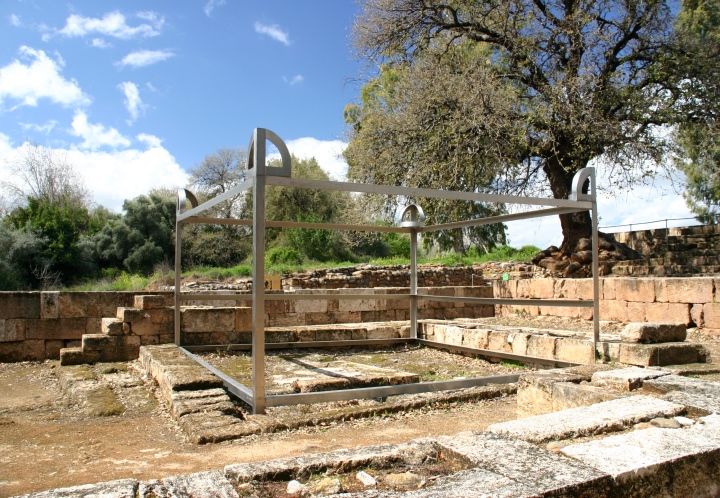
A
frame marking the size of the altar at Jeroboam's counterfeit temple
at Tel Dan.
Notice
that it utilized stairs, which God forbid, and likely used shaped stones.
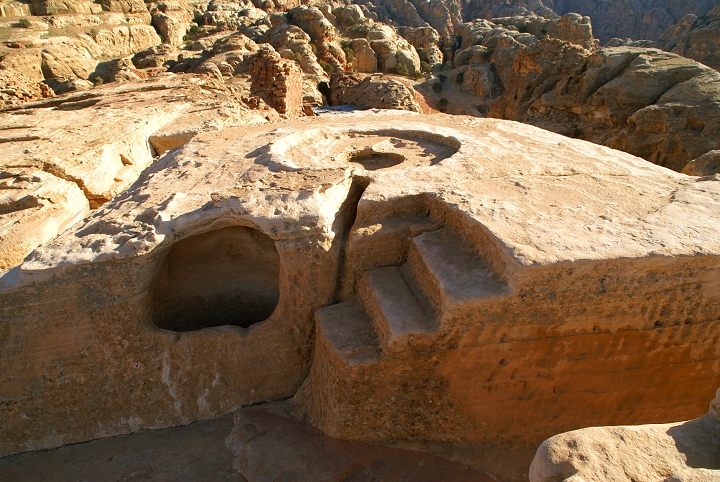
Altar
at the high place of Petra.
This
Nabatean place of sacrifice was used mostly for animals
but
there is some evidence that there may have been human sacrifices as well.
|
Does any sacrifice remain? Is there any longer a reason for any altar? The answer is "yes." Returning to the topic of the aroma rising heavenward from a sacrifice, its symbolism is further developed even in the Old Testament.
In the first established usage of an altar, Noah's sacrifice was said to have been a pleasing aroma to God. While those witnessing it would equate this with the natural aroma carried by the upward rising smoke, there is a spiritual truth behind this external. The Psalmist understood it, equating his prayers with sacrifice and the pleasing aroma of incense. The Law established, within their sacrificial system, an altar specifically for the purpose of burning incense. Again, being a copy of that which is in heaven, this separate shaped-altar further illustrated the need for a pleasant aroma to ascend into the presence of God.
With the demise of the earthly temple, its priesthood, and its sacrificial system, the only altars that matter are the two in heaven. The one, onto which Christ's blood was offered, never again needs to have blood spilt upon it. Never again is there need of blood sacrifice, as Christ's perfect and completely sufficient act was all that will ever be needed. The second, the heavenly altar of incense, retains the same purpose it has always had. This remaining altar is where the prayers of God's children are offered to Him! This is the final altar spoken of in the book of Revelation.
The entire life of a believer is a living sacrifice (Romans 12:1), truly a life of continual prayer in thought and deed (1 Thessalonians 5:17). This is a living sacrifice as there is no longer any need of a blood sacrifice and we have been permanently made alive in Christ (Galatians 2:20).
Our lives of prayer and praise ascend to the very presence of God, while the aroma also spreads to the world around us. But we don't smell the same to everyone.
|
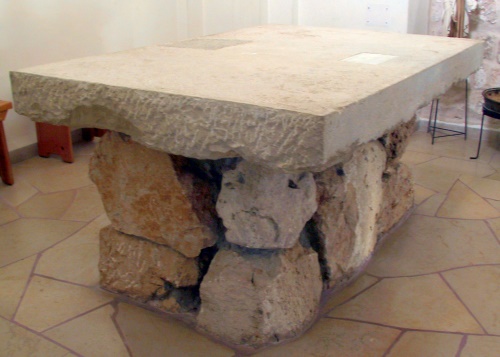
Altar at Carmelite Monastery on Mount Carmel in Israel
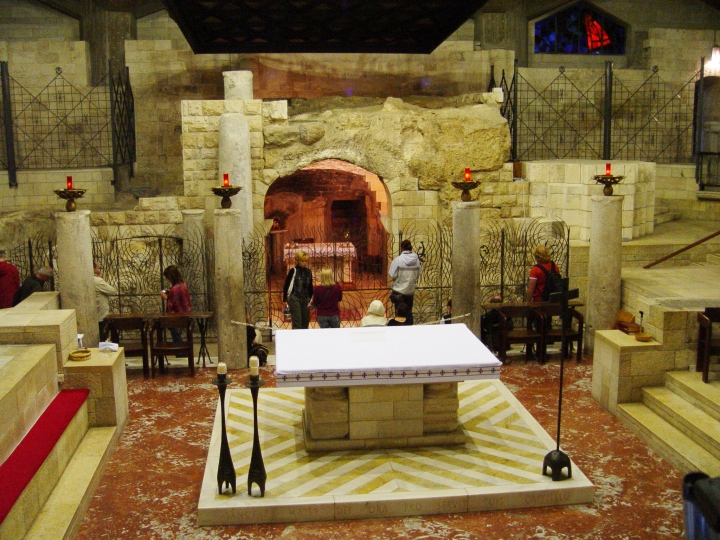
Two altars: foreground and in "cave". Church of the Annunciation in Nazareth.
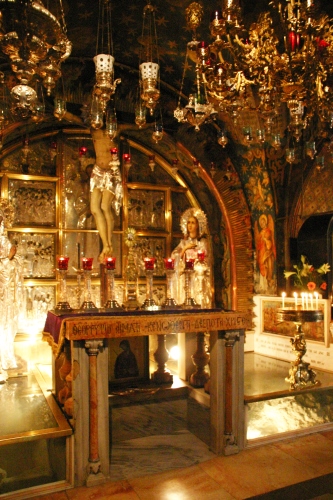
Greek Orthodox altar at the Church of the Holy Sepulchre, Jerusalem.
|
So why do some churches still have physical altars, albeit bloodless ones? To answer this question requires a brief overview of church history. The early church, in the generations immediately following the time of Jesus, had absolutely no altars. They rightly understood that Christ fulfilled all requirements for sacrifices and in so doing abolished any further need for the sacrificial altar. It was actually considered a mark of the early church that they had no altars, something thought especially strange to the pagans whose world was still filled with altars.
A pagan, named Celsus, writing circa 208 A.D., specifically asked this question...
Celsus used this question to claim that Christians actually concealed who they worshipped, trying to incite the populace against the Christians by fear of the unknown. The lengthy and public response to Celsus is worth an excerpt...
These early believers clearly understood that altars and temples were against the true way of serving God as revealed by Christ. They justly recognized the heart of a justified person to be an altar (i.e. a symbolic incense altar), a place were prayer ascends upward.
|
|
This understanding lost out to compromise over the next two centuries. Churches began to profess a need of the trappings of the pagan religions, albeit claiming that they used them for different purposes. With the decrees of Roman toleration and subsequently Roman adoption of Christianity, the newly institutionalized church desired huge and monumental edifices - symbols of her earthly authority and power. With these temples came an exclusive and powerful division between "laymen" and a professional clergy, soon called priests. The Lord's Supper became a perpetual bloodless re-sacrificing of Christ through the professed real presence of His body 4. That which was occasionally referred to as a "sacred table", to which all could gather in remembrance of Jesus, now became a place of sacrifice 6. Of course, any place of sacrifice by definition is an altar. This reinstitution of aspects of the Law, over time, became the norm throughout the Western (Roman Catholic) churches 7. Eastern churches, while retaining the physical appearance of a table, over time also began to refer to it as an altar.3 Elements of the Protestant Reformation, in an effort to return to the purity of Scriptures, understood the relationship of these new altars with their unbiblical continual sacrifice of the Mass. While virtually all reformers spoke against the Mass, others went further, especially in England. Here they also removed the altars. The Roman church still remembers and decries these actions...
It was not to last. Mankind's penchant for formality and ritual, attempting to better the simplicity and sincerity ordained by God, soon prompted churches to restore that which had been removed 5. Charles Spurgeon, writing on ritualism in 1869,2 notes the efforts of a commission to restore ritualistic elements to the English church, including altars. His Scripturally motivated disapproval of the restoration of these innovations shows throughout the whole. Take note of these quoted remarks regarding the Lord's Supper from one Bishop Hooper...
Spurgeon immediately followed this quotation with this commentary...
Later, quoting a Puritan named Mr. Smart, Spurgeon further records...
Rather than the Reformation continuing and all altars finally being removed, the small gains gave way to a return of altars in many Protestant churches. Even those who don't have full altars of the Roman Catholic variety have named their communion table, or the front of their sanctuary (or stairs to the platform), an altar. All too often congregants are told to come to the altar to pray 8, or the offering plates are placed on the table as if a sacrifice on an altar. All this misleads the people into thinking that physical altars are necessary in the church. The Reformation should have continued - needs to continue - all altars should have been removed.
|
|
The "altar" at First Baptist Church, 16th Street, Washington, DC (posted on Flickr)
The
"altar" of First Baptist Church, Orlando, FL
|
|
END NOTES 1. Ancient legends of the flood, corrupted and distorted by verbal transmission, show how the purpose of the sacrifice had become twisted. The sacrifice offered after the flood in both the Epic of Gilgamesh and in the Sumerian version feature libations, grain offerings, and meat sacrifices with a purpose of providing a feast for the gods. The implied intention of the flood hero in the Mesopotamian accounts was to use the sacrificial gifts of food and drink as a means of appeasing the anger of the gods. Similar symbolism pervades the use of sacrificial systems in hosts of other ancient and modern cultures. In the Epic of Gilgamesh, the starving gods (who had been deprived of food for the duration of the flood) gather around the sacrifice "like flies." 2. From Notes on Ritualism published in the Sword and the Trowel, by Charles H. Spurgeon, June 1869. 3. This excerpt from the Encyclopedia Britannica addresses the practices of churches outside of Roman Catholicism.
While it's true that many protestant churches have a communion "table", where it is placed at the front of the church is often commonly referred to as an altar, even if it is not the table itself being referred to. 4. The following are a few quotes showing how the Eucharist became a new sacrifice by the fourth century, one that would again require an altar:
5. This Christian dictionary definition of altar casually acknowledges a return to the usage of altars. It notes their original Old Testament usages, the silence and non usage of New Testament times and a subsequent revival even to modern times.
6. An excerpt from a book published more than a century and a half ago provides an excellent example of the Roman Catholic understanding of the Mass (and necessary altar) versus the Lord's Supper. The quotation begins after the cover page reproduction.
REASONS
7. The following excerpt, from an out-of-print edition of the Encyclopedia Britannica, helps explain how the non-altar table of the early church developed into the Roman Catholic altar filled with bones.
8. Many examples could be given. The "altar call" is a staple of many churches, to the point of being a test of orthodoxy for some. The first example I found, by a web search, turned up an East Mesa Baptist Church of Mesa, Arizona. Their web site says the following...
|

Mass (the bloodless sacrifice) being offered at the altar. Mount of Beatitudes, Israel
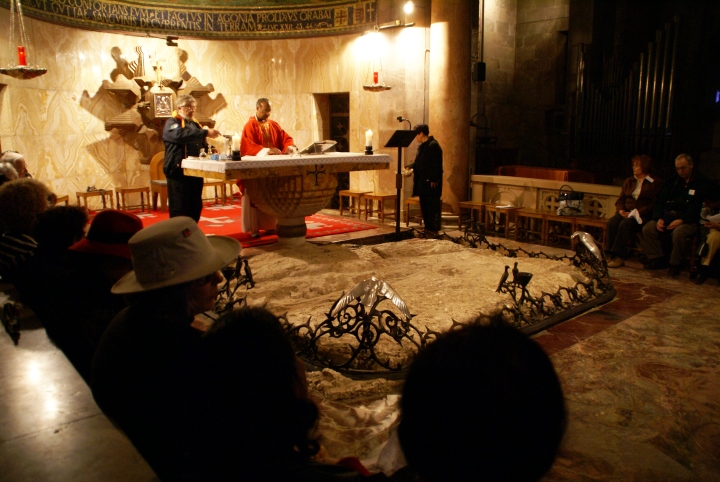
Roman Catholic Mass at the Church of All Nations, Garden of Gethsemane, Israel